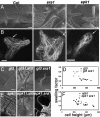A SPIKE1 signaling complex controls actin-dependent cell morphogenesis through the heteromeric WAVE and ARP2/3 complexes
- PMID: 18308939
- PMCID: PMC2268813
- DOI: 10.1073/pnas.0710294105
A SPIKE1 signaling complex controls actin-dependent cell morphogenesis through the heteromeric WAVE and ARP2/3 complexes
Abstract
During morphogenesis, the actin cytoskeleton mediates cell-shape change in response to growth signals. In plants, actin filaments organize the cytoplasm in regions of polarized growth, and the filamentous arrays can be highly dynamic. Small GTPase signaling proteins termed Rho of plants (ROP)/RAC control actin polymerization. ROPs cycle between inactive GDP-bound and active GTP-bound forms, and it is the active form that interacts with effector proteins to mediate cytoskeletal rearrangement and cell-shape change. A class of proteins termed guanine nucleotide exchange factors (GEFs) generate GTP-ROP and positively regulate ROP signaling. However, in almost all experimental systems, it has proven difficult to unravel the complex signaling pathways from GEFs to the proteins that nucleate actin filaments. In this article, we show that the DOCK family protein SPIKE1 (SPK1) is a GEF, and that one function of SPK1 is to control actin polymerization via two heteromeric complexes termed WAVE and actin-related protein (ARP) 2/3. The genetic pathway was constructed by using a combination of highly informative spk1 alleles and detailed analyses of spk1, wave, and arp2/3 single and double mutants. Remarkably, we find that in addition to providing GEF activity, SPK1 associates with WAVE complex proteins and may spatially organize signaling. Our results describe a unique regulatory scheme for ARP2/3 regulation in cells, one that can be tested for widespread use in other multicellular organisms.
Conflict of interest statement
The authors declare no conflict of interest.
Figures




References
-
- Molendijk AJ, Ruperti B, Palme K. Small GTPases in vesicle trafficking. Curr Opin Plant Biol. 2004;7:694–700. - PubMed
-
- Schmidt A, Hall A. Guanine nucleotide exchange factors for Rho GTPases: Turning on the switch. Genes Dev. 2002;16:1587–1609. - PubMed
-
- Rossman KL, Channing JD, Sondek J. GEF means go: Turning on RHO GTPases with guanine nucleotide-exchange factors. Nat Rev Mol Cell Biol. 2005;6:167–180. - PubMed
-
- Basu D, El-Assal SE, Le J, Mallery EL, Szymanski DB. Interchangeable functions of Arabidopsis PIROGI and the human WAVE complex subunit SRA-1 during leaf epidermal development. Development. 2004;131:4345–4355. - PubMed
Publication types
MeSH terms
Substances
LinkOut - more resources
Full Text Sources
Other Literature Sources
Molecular Biology Databases
Miscellaneous

